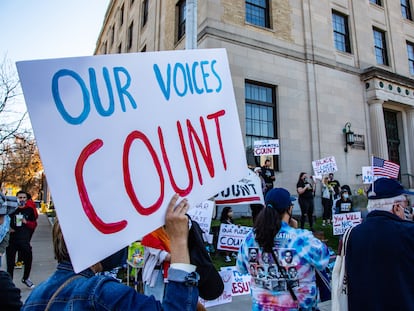Why America is a flawed democracy
Obstacles to voting, especially for minorities. The overrepresentation of sparsely populated communities. A dysfunctional Congress. The role of dark money in propelling candidates. The US democratic system, hailed as the longest-standing and most stable in the world, is far from perfect

In his new book, Berkeley Law School dean Erwin Chemerinsky envisions a solution to the problems he believes stem from the virtually unreformable U.S. Constitution: “A peaceful divorce, by mutual agreement, might come about where two or more countries would emerge,” he writes in No Democracy Lasts Forever. The West Coast states would form a new nation, called Pacifica, which could be joined by Democratic territories on the other coast, “and even Illinois.” Meanwhile, the Republican-majority regions of the South and Midwest would form their own country. Although Chemerinsky suggests an agreement between these new blocs to allow for free movement of citizens and trade.
Something is wrong when legal experts are forced to think like science fiction novelists. For Chemerinsky, it is the U.S. Constitution that is wrong. And he is not the only one who thinks this way. It’s a sentiment echoed by many voices, particularly on the left, who argue the flaws in this foundational document are a significant threat to the future of the world’s longest-standing and most stable democracy, which has enjoyed over two centuries of prosperity and freedom. According to this perspective, the U.S. Constitution, ratified in 1787 and left largely unchanged for 50 years, gives rise to three major problems: the establishment of the Electoral College, the structure of the Senate, and the functioning of the Supreme Court.
These problems — along with issues such as voter suppression and the influx of dark money in political campaigns — are not new. However, they gained a new dimension with Donald Trump’s rise to power in 2016, the same year The Economist index reclassified the United States from a full democracy to a flawed one. “We are still a democracy, but a very sick one,” notes Steven Levitsky, whose recent book, Tyranny of the Minority, co-authored with Daniel Ziblatt, serves as a stark warning about this decline. With the upcoming elections — arguably the most significant in recent memory — there is a crucial opportunity to analyze the system’s failures and propose potential solutions with insights from experts.

The Constitution, untouchable?
From the musical Hamilton to the requirement for elementary school students to memorize its preamble, the Constitution remains a revered part of American life. But is a document written over two centuries ago for a small, budding nation still useful? “No one could have imagined then that it would become such a large and expansive republic,” warns Josep M. Colomer, a political scientist at Georgetown University. “Its drafting was a new experiment, and, consequently, its drafters paid the price.”
Amending the Constitution is so challenging that this reality has often stifled debate before it even begins. A two-thirds majority in both Houses and the agreement of three-quarters of the 50 states are required, numbers that are currently out of reach given the stark divisions in the Senate and House of Representatives. The Constitution has been amended 27 times, with the first 10 amendments, known as the Bill of Rights, ratified just four years after its approval. The last amendment came in 1971, which lowered the voting age to 18.
Those advocating for urgent improvements — or even a complete rewrite — argue that significant social changes of the past 50 years believe that such a feat is possible. They point out the original sin embedded in the document: it makes no provision to abolish slavery. Conversely, those who view the Constitution as a marvel of adaptability — an argument almost always made by conservatives — cite the abolitionist Frederick Douglass, who said: “The Constitution does not mean what it says.” Political scientist Yuval Levin, who believes that the Constitution is the “solution and not the problem” for American democracy, aligns with this view. These are once again, two irreconcilable positions. As historian Jill Lepore writes in These Truths, “The United States is founded on a set of ideas, but Americans have become so divided that they no longer agree, if they ever did, about what those ideas are, or were.”
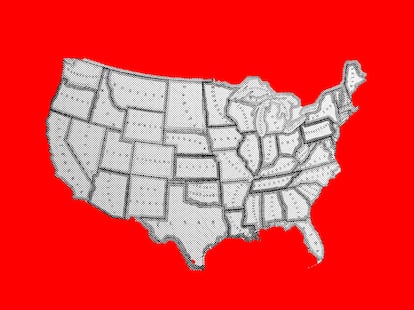
President against the will of the people
The United States is the only presidential democracy in the world in which the president is not directly elected by voters, but by an Electoral College. This makes it possible for the president to be elected without a majority of the votes: George W. Bush and Donald Trump came to the White House with fewer votes than their opponents, Al Gore and Hillary Clinton, in the elections of 2000 and 2016, respectively. This scenario could potentially happen again on November 5.
The Constitution allocates each of the 50 states a number of electors in the Electoral College that matches its representation in both the House and Senate. Except for Maine and Nebraska, the candidate who wins a state’s popular vote secures all of its electoral votes, regardless of whether the margin of victory is one vote or three million. To win the presidency, a candidate must obtain 270 out of 538 electoral votes. Despite the Electoral College’s outdated and potentially anti-majoritarian nature, it has its proponents. Dennis Prager, a figure from the American right, argues that it represents a “brilliant idea” by the founders, who “didn’t want a democracy, they wanted a republic.” However, according to Levitsky and Ziblatt, the notion that the Electoral College is an integral part of a well-designed system of checks and balances “is a myth.” It was, in fact, a compromise born out of a lack of better options.
Colomer explains that the system was established at a time when political parties were not anticipated. It was expected that if a candidate did not secure a sufficient majority in the Electoral College, the decision would then be deferred to the House of Representatives. “This reflects a lack of understanding of how democracy would function in a new nation — one without prior experience, precedents, or examples from other countries to draw upon,” he notes.
The winner-takes-all rule, coupled with the overrepresentation of less populous states, enables a candidate to win the election even after losing the popular vote. Currently, this dynamic benefits the Republicans, who tend to perform better in states that are disproportionately represented. In most states, there is a clear frontrunner, leaving only seven states in play: Arizona, Georgia, Michigan, Pennsylvania, Wisconsin, Nevada, and North Carolina. “The U.S. presidency has come down to a small handful of voters in few swing states. As I argue it, 150,000 to 200,000 swing voters in a few swing counties in a few swing states will decide the next president of the United States,” warns David Schultz, editor of Presidential Swing States.
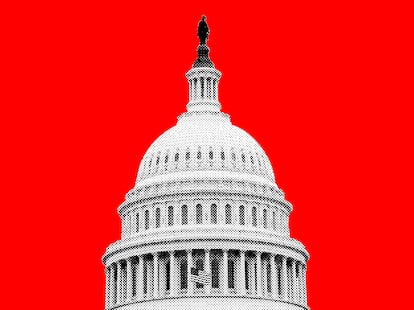
Legislative gangrene
The imposing U.S. Capitol in Washington houses a dysfunctional Congress. The Senate — where 100 members serving six-year terms and one-third of the seats are renewed every two years — operates as a chamber of territorial representation, granting each state two senators regardless of population. This structure results in the overrepresentation of less populous states. Uniquely, the Senate wields more power than the lower chamber, the House of Representatives. The House comprises 435 members who are renewed every two years based on population criteria, but its composition has remained unchanged since 1929.
For any law to be approved, it must be green-lighted by both chambers. When each party holds a majority in one of the two chambers, as has been the case since 2023, it often leads to legislative paralysis and the risk of partial government shutdowns because it is difficult to pass the budget. This situation is exacerbated by the polarization between parties, which extends to the institutions, as explained by Colomer.
A majority in the Senate, which holds the authority to ratify the appointment of federal judges — including those on the Supreme Court — and other high-ranking officials, can be achieved with a minority of votes, similar to the presidential election process. However, less populated states are unlikely to agree to any constitutional reform that would reduce their overrepresentation, which again currently benefits the Republican Party.
As if this distortion were not enough, the Senate’s regulations opened the floodgates for filibustering. Originally, a matter couldn’t be brought to a vote until the debate had concluded, resulting in marathon speeches that were only used in extreme situations due to their exhausting nature. However, the rules were revised, allowing senators to simply express their desire to continue discussing an issue without having to keep the debate active. Additionally, a qualified majority was established, enabling a bill to be put to a vote at any time. This has effectively meant that nearly every law requires 60 out of 100 votes for passage. The silver lining is that abolishing the filibuster does not necessitate any constitutional or legal changes, leading many to believe its days are numbered.
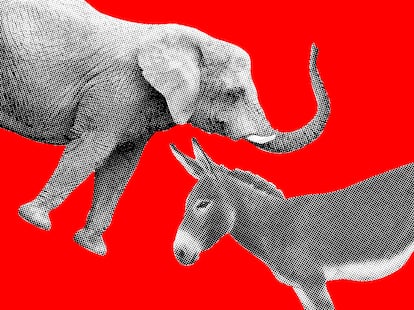
The bipartisan trench
For its critics, there’s no clearer illustration of the crisis facing the American two-party system — something George Washington warned about — than the dynamics between both parties and their candidates in this election cycle. On one side is a figure who, despite inciting an insurrection and being convicted of 34 serious crimes, has managed to reshape the Republican Party in his own image, effectively sidelining both the old guard and newer conservatives, who, nine years later, remain unable to stop him. On the other side is a candidate who was not chosen in the primaries but assumed control of the Democratic Party — fueled by an initial wave of enthusiasm among supporters — following Joe Biden’s resignation. No one dared voice concerns until Biden’s diminished capabilities became painfully clear in public settings.
In addition to losing the safeguards that once helped prevent the rise of figures like Trump, both parties have, over the last decade, abandoned their previous aim of encompassing a wide range of voices (à la Walt Whitman) and have instead entrenched themselves further as polarization has intensified in American public life. Until that point, “America,” as Lee Drutman puts it in Breaking the Two-Party Doom Loop, “operated more like a multiparty system.” To reverse this trend, Drutman advocates for reforming the current electoral system, based on the winner-takes-all principle.
According to Gallup, the percentage of people who would welcome a third party is at a record high, with two-thirds in favor. However, history suggests that this may not be realized. Those who have attempted to forge a third way have consistently faced failure. As American historian Richard Hofstadter (1916-1970) succinctly puts it: “Third parties are like bees. Once they have stung, they die.” In other words, the most they can hope to achieve is to hurt one side or the other and then die.
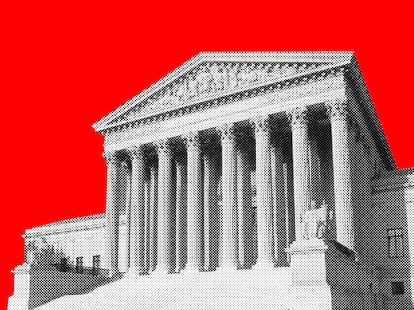
A Supreme Court justice is forever
More oddities: The United States is the only democratic system in the world where Supreme Court justices serve for life. In contrast, all other established democracies impose term limits, mandatory retirement ages, or both, as noted by Levitsky and Ziblatt. This life tenure was established when life expectancy was much lower, and the role of the justices was less significant, so it was not uncommon for justices to retire mid-career.
As University of Massachusetts law professor Paul Collins explains, this system has contributed to the court’s sharp shift to the right, fundamentally altering American society in areas such as reproductive freedom, gun control, and civil rights. This shift is due to the fact that the conservatives have a supermajority of six justices against three liberals. What’s more, the Republicans achieved this feat despite only winning the popular vote once since 1992. Trump — who did not win the popular vote — appointed three of those justices. As a result, popular support for the Supreme Court has plummeted to historic lows, largely due to its disconnect from public opinion and the ethics scandals surrounding some of the justices.
“The two most urgent reforms are term limits for justices and the implementation of a mandatory code of ethics,” Collins says. This is a proposal that the current president, Joe Biden, launched as part of his plans for leaving office, shortly after announcing that he would not seek re-election. Collins sees little future for it. “Given that the issue of Supreme Court reform has become so polarized — with Democrats generally in favor and Republicans against — it is unlikely to happen unless the former take control of both the House of Representatives and the Senate, and are willing to eliminate the filibuster,” he explains.

Gerrymandering: The salamander that bites its own tail
Gerrymandering, the distinctly American practice of drawing electoral districts for partisan gain, is a complex mechanism best summarized by a phrase often used by Congressman Jamie Raskin, one of the most influential voices in the Democratic Party: “This perverse practice allows politicians to choose their voters, not the other way around.”
This process occurs every 10 years following the release of the new census. State legislators draw up voting maps for federal, state, and local elections, often crafting convoluted shapes designed to benefit their own party by diluting the electoral strength of their opponents. The term “gerrymandering” is derived from Elbridge Gerry (1744-1814), the fifth vice president of the United States, who, in an effort to favor a friend, devised a district shaped like a salamander (hence the latter part of the neologism).
Both parties engage in this practice, although it tends to be more extreme in states governed by Republicans. Gerrymandering often triggers a cascade of legal challenges that can delay the implementation of new maps for several years. It resembles a salamander biting its own tail, as its objective is to allow those in power to perpetuate their hold on it. Additionally, this practice discourages its victims — typically minorities such as African Americans, Latinos, or Asians — who lose interest in politics when they feel unrepresented.
Experts identify three tactics used against these minorities: diluting their influence within a majority white population (stacking), separating them from their original district (cracking), or packing them into other counties where their votes are essentially disregarded because they are already considered lost (packing).
“The solution to the problem is clear,” explains analyst Ricardo Ramírez, a specialist in voting rights: “Take the process out of the hands of politicians, separate it from ideology and entrust the task to an independent commission.” Nine states, including California and New York, have already adopted this approach. “It is the only way forward at a time like this, when there is so much division,” says Ramírez.
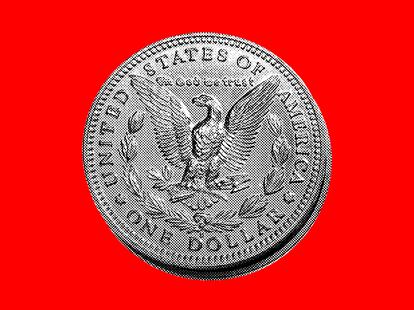
Campaign financing: dark money
In 2008, the Federal Election Commission banned Citizens United, a conservative nonprofit organization, from running three ads for Hillary: The Movie, a film critical of then-candidate Hillary Clinton, due to its violation of a century’s worth of campaign finance restrictions. This legal battle culminated two years later in a Supreme Court ruling that permitted corporations and other external entities to spend unlimited amounts on election campaigns. The latest example of this shift in the rules of democratic engagement surfaced recently, revealing that the world’s richest man, Elon Musk, had spent $75 million in efforts to return Trump to the White House.
The five justices who voted in favor of the ruling believed that transparency in donations would suffice to prevent corruption within the system. However, the Supreme Court did not anticipate that a significant portion of this enormous influx of money would be funneled through entities known as Super PACs, which can accept donations from opaque organizations financed anonymously. These donations, referred to as “dark money,” provide funding to both parties equally. Spending on campaigns by corporations and other outside groups surged by nearly 900% between 2008 and 2016, reaching a record $14.4 billion in 2020. During that cycle, Super PACs alone spent $3.4 billion, with almost 70% of that funding coming from just 100 donors. In that presidential campaign, Biden outpaced Trump in fundraising.
This issue is connected to the crisis of the party system, which has become vulnerable and stripped of its former substance explains Mary Ziegle, a professor at the University of California’s Davis School of Law, who examined how the anti-abortion movement inundated the Republican Party with funds until this ultimately “hijacked” the party. “It destroyed its traditional hierarchy,” she explains, arguing this paved the way for “populist leaders,” provided “they fulfilled the objective of placing justices on the Supreme Court willing to criminalize abortion.”
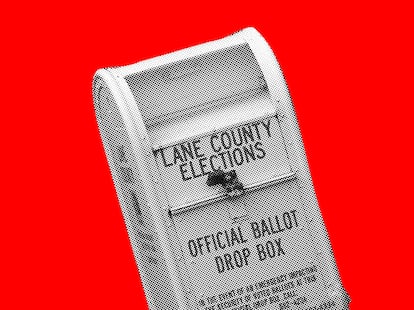
When voting is an obstacle course
In most countries, the state actively encourages participation in elections. Elections are typically held on Sundays, citizens receive work permits to go vote, and census data is compiled automatically, eliminating the need for registration. “In the United States, it is difficult to register, it is difficult to obtain information on how to vote, voting is done on a workday… The right to vote is not in the Constitution,” Levitsky explained in a recent conversation. Moreover, each state regulates access to the ballot box differently: some make it easy, while others impose obstacles that disproportionately affect minority groups.
Turnout is typically low. In 2020 — which set a record for the past few decades— turnout was just 67%. Following this record and in light of Trump’s defeat, unfounded accusations of electoral fraud sparked an unprecedented wave of legislation aimed at making voting more difficult in places like Georgia.
“Voters in more than half of the states will face obstacles to voting that they have never encountered in a presidential election,” warns the Brennan Center for Justice, referring to what is commonly known in the United States as voter suppression. This term describes laws — mostly promoted by Republicans — that impose requirements that disproportionately stop minorities — who tend to vote for Democrats — from voting.
Since 2020, at least 30 states have enacted 78 restrictive laws. Ohio Democratic Congressman Greg Landsman has a clear solution: “Pass the John R. Lewis Voting Rights Act,” a measure that has been repeatedly blocked by Republicans on Capitol Hill. This law aims to restore protections by requiring jurisdictions with a history of voting discrimination to obtain approval from the Justice Department or a court before changing their voting laws. “Ohio used to be a famous swing state,” Landsman states. “If they let people vote, it would be one again.”
Sign up for our weekly newsletter to get more English-language news coverage from EL PAÍS USA Edition
Tu suscripción se está usando en otro dispositivo
¿Quieres añadir otro usuario a tu suscripción?
Si continúas leyendo en este dispositivo, no se podrá leer en el otro.
FlechaTu suscripción se está usando en otro dispositivo y solo puedes acceder a EL PAÍS desde un dispositivo a la vez.
Si quieres compartir tu cuenta, cambia tu suscripción a la modalidad Premium, así podrás añadir otro usuario. Cada uno accederá con su propia cuenta de email, lo que os permitirá personalizar vuestra experiencia en EL PAÍS.
¿Tienes una suscripción de empresa? Accede aquí para contratar más cuentas.
En el caso de no saber quién está usando tu cuenta, te recomendamos cambiar tu contraseña aquí.
Si decides continuar compartiendo tu cuenta, este mensaje se mostrará en tu dispositivo y en el de la otra persona que está usando tu cuenta de forma indefinida, afectando a tu experiencia de lectura. Puedes consultar aquí los términos y condiciones de la suscripción digital.

